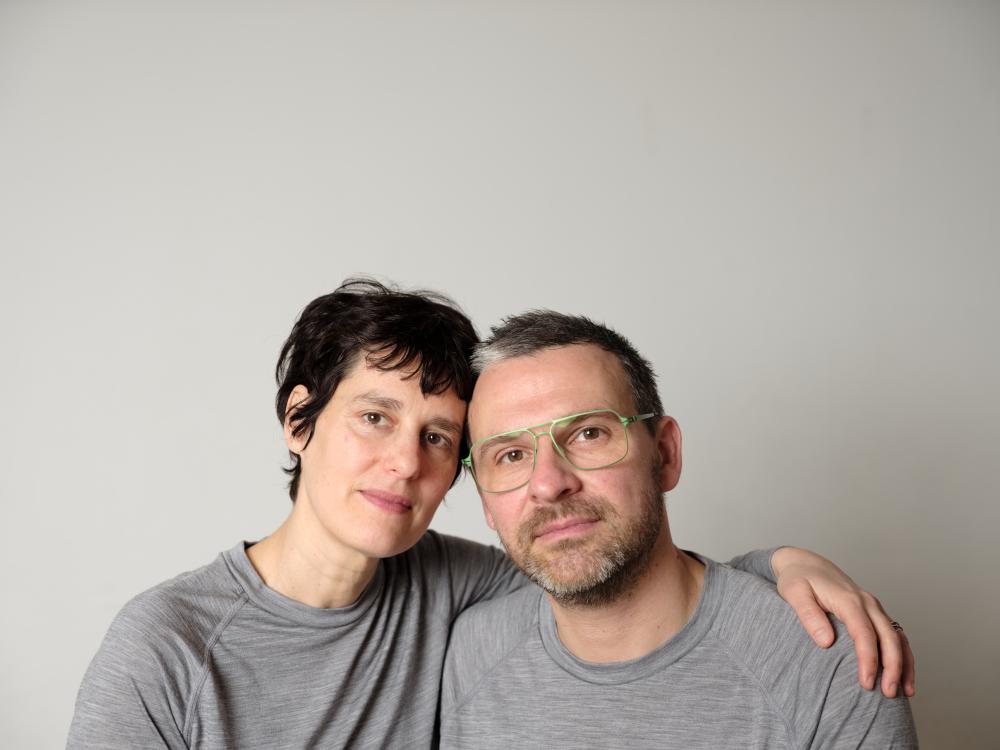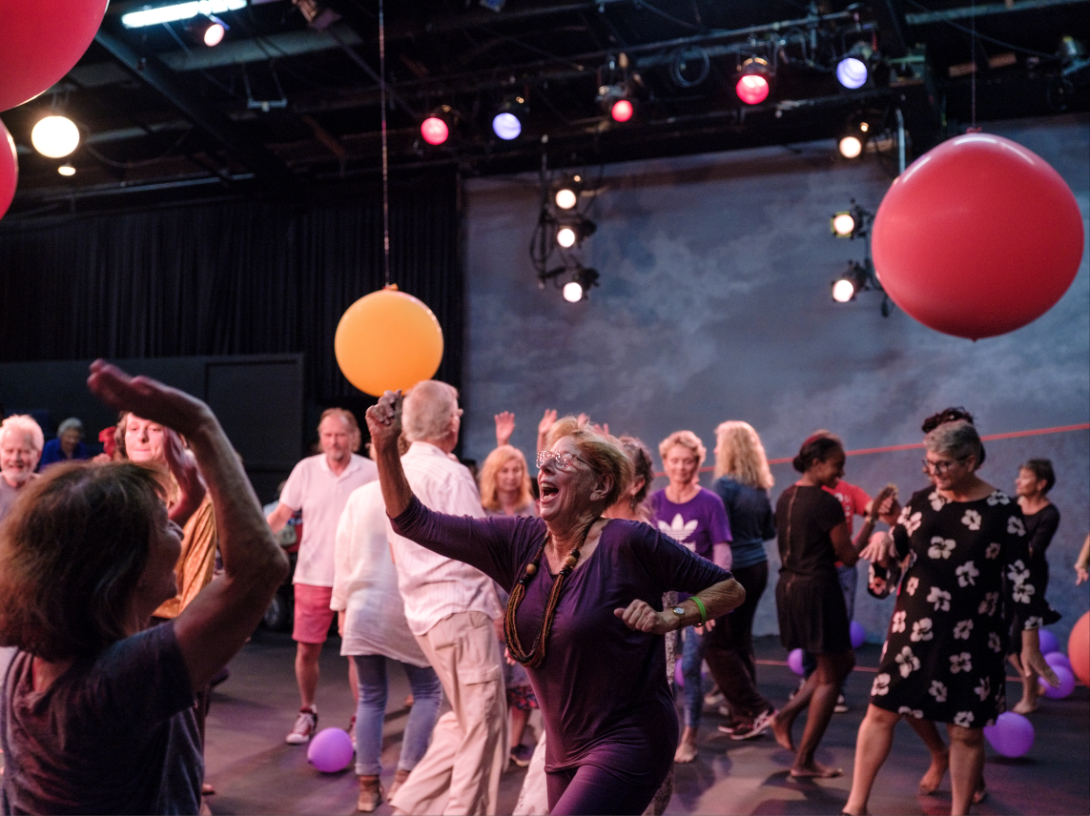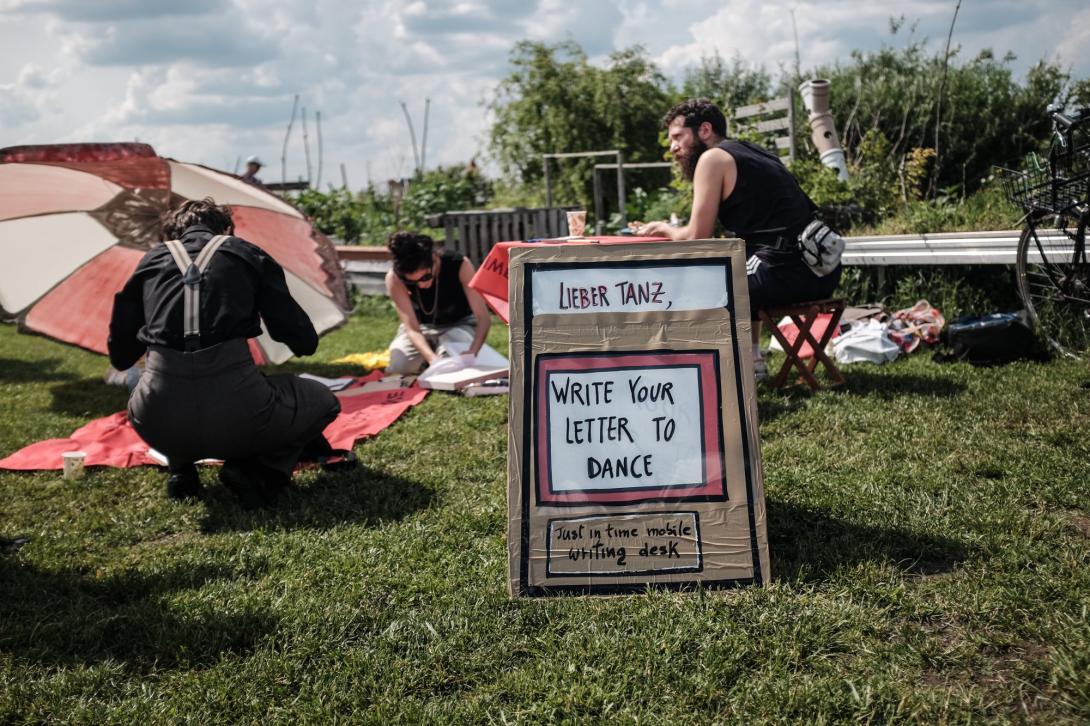‘We Don’t Rehearse, We Just Collect Letters. And Afterwards The Ball Starts.’
A conversation with deufert&plischke
What would you tell dance if you had the chance to meet it? What is your favourite dance move? The artistic duo deufert&plischke make this encounter possible in their project Letters to Dance/Just in Time. The first part of the project consists of workshops in which the participants are invited to write a letter to dance. In the second part, everybody comes together for a ballroom party, to dance. The project travels from one city to another, all over the world – from Los Angeles to Berlin to Tel Aviv. This spring, they’ll land in Brussels, a city famous for its dance community.
Where did this idea of writing letters to dance come from?
It actually started as a dance heritage project. We had this idealistic idea of writing a personal dance history and we hope that this project can go on for another fifteen years and all over the world. We made a webpage where we have collected everything since the beginning, as a history archive. We chose the epistolary form because it encourages people to put all kinds of feelings into words: personal, political, cultural, sexual... We’ve never seen so many stories connected to precarious lives, to frustrated relationships, to unhappy careers. Dance brings it all together.
In a letter you address someone to whom you can start telling your story. The format really empowers people to say things that they wouldn’t tell us otherwise. For example, in the Los Angeles version, we did a workshop in the small industrial town of Camarillo, where we met a community in the Latin American scene. The group was called Teatros de las Americas. It consisted of eight people from Latin American countries, all aged over 60. In the end, it turned out that half of them came out during the workshop, which is still a big taboo, especially in dance in the Latin American tradition. For the first time, they admitted that they were dealing with dance in their lives in order to get in touch with people of the same gender.
Writing slows down your thought process and a letter has an intimate quality, especially when written by hand. Is that why you insisted that the letters should not be written digitally?
The handwritten aspect offers something which is quite unique in our present digital times: the text becomes physical and you can give it away to someone. After writing the letter on paper, the participants give away their letters to the performance. They make something which they lose. They create something not only for themselves but open it up to others. We consider this to be an artistic action even though we don’t think the participants necessarily see it that way.
One of the recurring questions in all of your pieces is about how we want to live. How do you relate these letters to this question?
We often get asked what dance means to us, especially in the context of this project. The relation between how to live together and the letters becomes clear when we speak about this workshop situation: we spend three or four hours with people who we mostly don’t know at all. We don’t know their backgrounds or their aims. In this moment, dance really becomes the common ground, the framework where we start and where we end. We enable a kind of social situation, a moment that we share with them in which many things are at stake. These things are all connected to the notion of dance. We start the workshops with writing the word dance on a paper and then we ask the people what words they connect with dance. One might write ‘fun’ and ‘joy’ but somebody else might write ‘pain’ and ‘fear’ or ‘shyness’. This clash of notions helps the people to see it as a game and it opens up the conversation. Before long, everybody starts sharing their little stories with dance.
You sometimes describe these social situations as utopian worlds, which could be perceived as slightly naive when confronted with our current polarized world, especially if we think of what Timothy Snyder calls ‘the politics of eternity and politics of inevitability’. Both forms take away the agency of the citizen and keep them passive. Your work is very different because the audience is explicitly activated. How do you situate your work with respect to these political visions?
For some reasons, dance in its social history – not in its art history – very often had this function of a utopian place. In Berlin, we met many communities where dance situations become parallel worlds. You see this clearly in Turkish wedding dances, for example, where dancing is a way to temporarily forget about the everyday struggle. Of course, that is a very problematic approach too because you dance beyond any mind or political opinion. But in contrast to other artforms like painting or literature, dance has this community aspect. In weddings you don’t do writing marathons and you don’t paint images together. These dance community roots are appearing on both experimental and established stages in the West, which perhaps adds a political dimension: it makes aspects of dance visible that would otherwise stay hidden. For example, the Turkish wedding dances would be reserved only for wedding ceremonies.
Your previous pieces took place in smaller forms for a smaller audience. In Letters to Dance, you open up to a larger audience. Were you looking for a way to open up your work to a larger public?
We don’t know if this was a conscious decision. More than anything else, it is part of the development towards a participatory approach that has been taking place over the past ten years. There was a moment when we were no longer happy with a ‘passive’ audience that would just sit and watch. We started looking for approaches in which the audience moves and has the freedom to have a deeper experience of what we do. We wanted to weaken this strong separation between performers and audience. In 2009, for example, we made Anarchiv #2: second hand with DD Dorvillier and Cecilie Ullerup Schmidt, where we gave our choreographic material to other choreographers and where the audience reconstructed the whole performance at the end. As a consequence, we started to observe our audiences much more carefully: who are they, where do they come from? Especially when we moved to Berlin in 2010, we discovered that the dance scene is very limited. You basically always meet the same people everywhere: not only in our own pieces but also in the pieces of other choreographers. This made us very uncomfortable. It limits the discourse. We do not think that it is a good way of dealing with an artform such as dance, which is intended to have a broader approach because it does not use many words. All the claims that have been made in dance since the 1960s should also be transposed to the relationship between performers and audience or the artwork and its reception. So we slowly started to develop pieces in which we reconsidered the relationship between performer and audience. We started to open up the work to communities, to non-professionals, to everybody. In the beginning it was difficult because you cannot just open the door and let everybody enter. Nobody would come in.
In Letters to Dance you look for larger audiences by organizing workshops.
Yes, we are artists and teachers at the same time, and we have taught many workshops over the past ten years. At one point we thought: if we do workshops, then we can speak to people before the actual performance. In Letters to Dance, we combined the teaching and creating in a very consistent way, but we had previously made pieces such as Entropic Institute (2012), Emergence Room (2010) and Niemandszeit (2014). In each of these performances, we chose an open format in which we ‘made our audience’: we contacted people, and we let them participate beforehand. Their experience becomes very different than if they were only to go to the performance because they know more and feel safer.
You developed the concept of New Epic Theatre. How does Letters to Dance/Just in Time fit into this concept?
This notion comes from Durcheinander, our previous piece. ‘Durcheinander’ means ‘one through another’ but also ‘mixed up’. It also refers to our work, which is quite ‘durcheinander’. In Durcheinander, we worked with ten artists to create a 24-hour space where people could sleep and live, which was quite messy. We collaborated with Hans-Thies Lehmann and his partner Helena Varopoulou, both older theatre experts, and we asked them to write a letter to Bertolt Brecht together. Brecht, who created the notion of the Epic theatre at the beginning of the twentieth century, talked about the need for little theatres and pop-up structures, of clever performers and new timings (such as durational pieces). He said we needed theatre as living rooms, as academic places and as parliaments. When we talk about New Epic Theatre, we extract the principles of this thought. They’re all aspects that we find very relevant to think about in our work: are people allowed to express their opinions in our pieces? Are they allowed to live together? To exchange knowledge? In Durcheinander this was very intense. Letters to Dance fits into the same framework, but in a more relaxed, joyful, charming way.
What the title ‘Letters to Dance’ refers to is obvious, but why is the piece also called ‘Just in Time’?
When you do something ‘just in time’, it is neither too early nor too late. In the pilot phase of the piece in Berlin in 2016, we collaborated with five choreographers and we went around gathering letters everywhere throughout the city. We had a pop-up construction with a portable letter writing desk and a portable workshop space. We hoped to grab a piece of dance history on the spot, so to speak, from the people we encountered at that particular moment. We asked passers-by: ‘do you want to write a letter to dance?’ So Just in Time refers to the tempo, the dynamics, the instant quality of the project. We don’t rehearse, we just collect letters and meet in different places and with different people every time, and afterwards the ball starts. And that’s something very fragile. It has to occur at exactly the right time. And we think the setting of Dag van de dans (The Day of Dance) will be very suitable to be just in time again this time!
a conversation with deufert&plischke, by Eva Decaesstecker (Kaaitheater, January 2019).
(1) Politics of eternity and politics of inevitability are both concepts from Timothy Snyder’s The Road to Unfreedom. The politics of inevitability is a neoliberal vision, in which everything is determined by the economic capitalist evolution, which returns every disorder to an equilibrium. The politics of eternity is a totalitarian vision in which the state presents itself as the protector of its citizens, eternally fighting the enemy, i.e. everything from abroad. Both visions annihilate civil participation: in the first everything is determined, so there is no use trying to propose something different; in the second the state protects the citizens, so the only thing citizens have to do is to keep faith in their nation.


